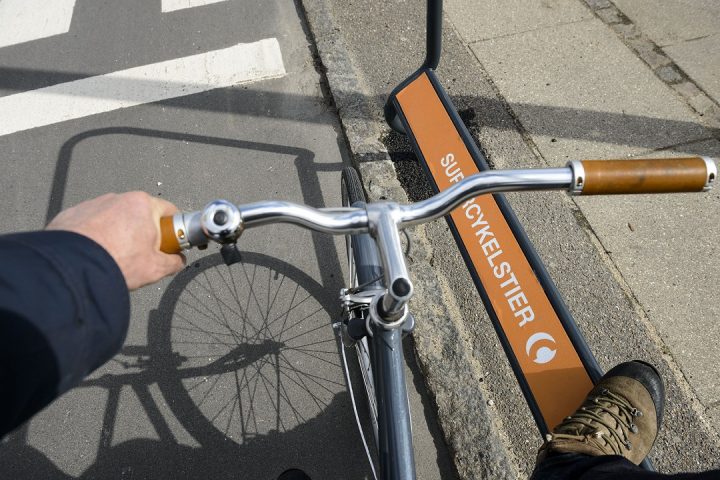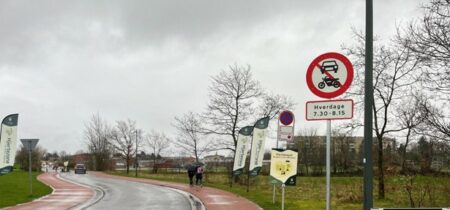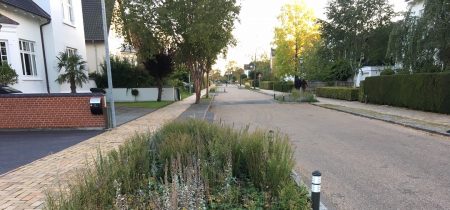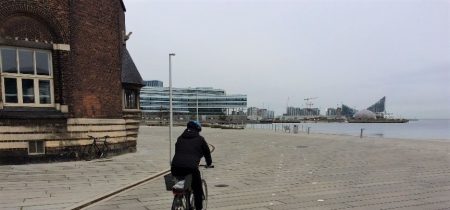Cycle superhighways
Cycle superhighways are for super cyclists who want to cycle further than the majority. To that end a number of facilities can be installed on the routes to make cycling faster and easier. The cycle superhighways get more people to cycle and are an excellent societal investment.
By Troels Andersen

- The plan for expanding the cycle superhighways network in Aarhus municipality consists of four main elements
It just makes life easier, says the busy mother or father, hurriedly packing the car on a cold winter morning. It is true that the car is often the only way to get everything done, but not always.
The cycle superhighway is a new concept that aims at challenging cars on middle distances of 5-10-20 km or more. It’s the second generation of cycle routes.
It started in Odense at the turn of the millennium, and went under different names (cycle motorway, commuter route, etc.) Today, for example, the concept is known as bicycle commuter routes in Aalborg whereas cycle superhighway is the accepted term in larger cities and the capital region of Denmark.
Unfortunately, or perhaps fortunately, there is no precise definition of what constitutes a cycle superhighway because different areas have different needs, available space, and finances. Each route is often unique and is designed according to the circumstances. However, the feature they have in common is that they strive to provide an extra element that can attract new cyclists.

- Here’s how you give a cycle track tunnel an esthetic boost by means of LED decorations. Photo Cycle superhighways, capital region of Denmark
Each local authority and region has a plan for a cohesive network of cycle superhighway routes of high quality, often across municipal boundaries. The cycle superhighway network is intended to make it easy, flexible and secure to get from point A to point B across the entire municipality/region. The cycle superhighways link workplaces, educational institutions and residential areas. The routes are constantly being expanded and usually run along collective transport routes, i.e. trains and busses, which makes it easier to combine a bicycle trip with other transport modes. This means better urban environments, less congestion, and improved public health.
The cycle superhighways are planned to provide the most direct route with as few stops as possible and a high degree of comfort. Cycle superhighways typically have even surfaces, green waves, bicycle bridges, bicycle tunnels, countdown signals, bicycle pumps, service stations, improved lighting, wayfinding guidance, and a high level of operations and maintenance. The cycle track width of all cycle superhighways is as wide as the urban space permits so there is space for the fastest cyclists as well as cyclists who simply wish to enjoy the surroundings. The key word here is accessibility, but this must not be at the cost of the safety of children and the elderly.
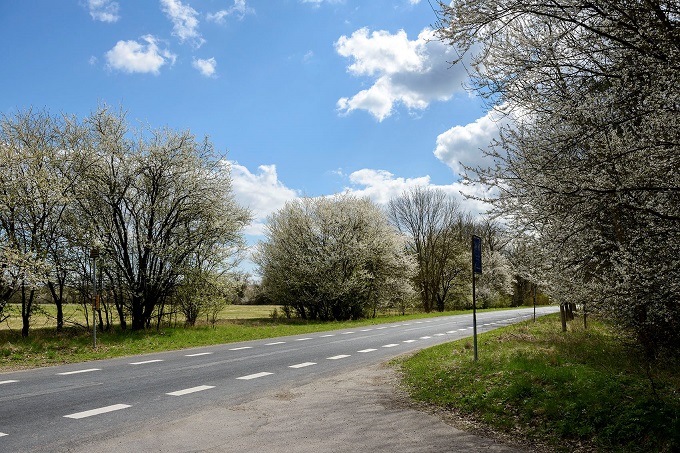
- So-called “Two minus one” roads (edge lane roads ) are also occasionally part of a cycle superhighway when there are not many cars or cyclists. Photo cycle superhighways, capital region of Denmark
The capital region of Denmark
In the capital region 23 local authorities and the Capital Region of Denmark are working together to establish good cycling connections across municipal boundaries, intended to make it easier and safer for commuters to choose the bicycle as their transport mode. Cycle superhighways especially target cycle commuter needs, and allow cyclists to expect a continous, uniform standard across municipal boundaries. The aim of the cycle superhighways is to create a competitive alternative to cars and thereby increase the number of cycle commuters in the capital region.
Today the cycle superhighway network links 19 municipalities via 8 cycle superhighways. The vision for the cooperation is to create a network that links the local authorities across the region via a total of 45 cycle superhighways over a total of 746 km.
Cycle superhighways quality objectives
The Road Rules manual on cycle superhighways defines the following quality objectives:
- Access – cycle superhighways should enable users to have access to a logical and direct cycle route between home and workplace or educational institution.
- Accessibility – cyclist superhighways should give users good accessibility with the fastest option for cycling between two areas.
- Safety and security – cycle superhighways should offer users a good, safe design and a high degree of security.
- Comfort and experiences – cycle superhighways should give users the most comfortable route between two areas along with interesting experiences.
- Recognizability and identity – Cycle superhighways should be launched as an especially attractive offer, and users should be able to easily recognize and find the cycle superhighways.

- The service station makes it possible to fix a puncture or make adjustments on the way. Photo: cycle superhighways, capital region of Denmark
Advantages of cycle superhighways in Odense
The plan is that eventually the Odense cycle superhighway network will consist of 13 routes although there will not be the same advantages on all the routes:
- Wider cycle tracks.
- New wearing course providing a better surface.
- Blue lanes at intersections to make drivers more aware of cyclists, and to promote security.
- Bicycle tunnels and bridges over several major roads.
- Bike boxes to allow cyclists to enter the intersection before cars, which promotes safety.
- Cycle tracks in roundabouts to make cyclists feel more secure.
- Bicycle streets, where cyclists have priority in the entire traffic lane and where cars may drive max. 30 km/h.
- Electronic bicycle counters that count the number of cyclists.
- Rain sensors that give cyclists a longer green phase in rainy weather.
Cycle superhighways are always cleared of snow and ice since the cycle tracks have major approach road priority.
Who uses the cycle superhighways?
Super cyclists are commuters who see the advantage of biking to and from work. It’s healthy, easy, and safe. And anyone can do it. Cycle commuters’ primary motivation for cycling to work is for exercise and health. Although cycle commuting is not always the fastest transport mode, many super cyclists consider it a time-effective transport mode because they get exercise during their daily transport. At the same time they get fresh air and a breathing space where they can relax.
Experience in the capital region of Denmark shows:
- 8-61% more cyclists after the cycle superhighway opened.
- 25% of new cyclists on cycle superhighways are former drivers.
- 90% state that cycle superhighways live up to their expectations.
- The average trip on the Farum route is 14.7 km.
Cycle superhighways are good business
There is a cost-benefit analysis of cycle superhighways in the capital region of Denmark. Measured by the internal interest rate of 11 % the cycle superhighways are at least as profitable as major infrastructure projects.
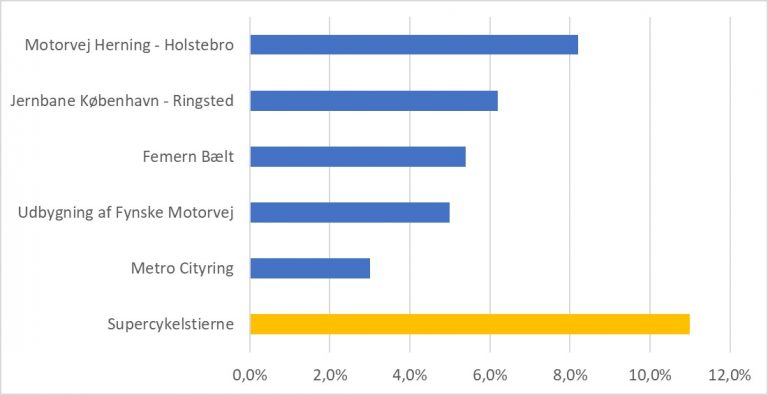
- Measured by internal interest the cycle superhighways are at least as profitable as major infrastructure projects. Source. Cycle superhighways, capital region of Denmark
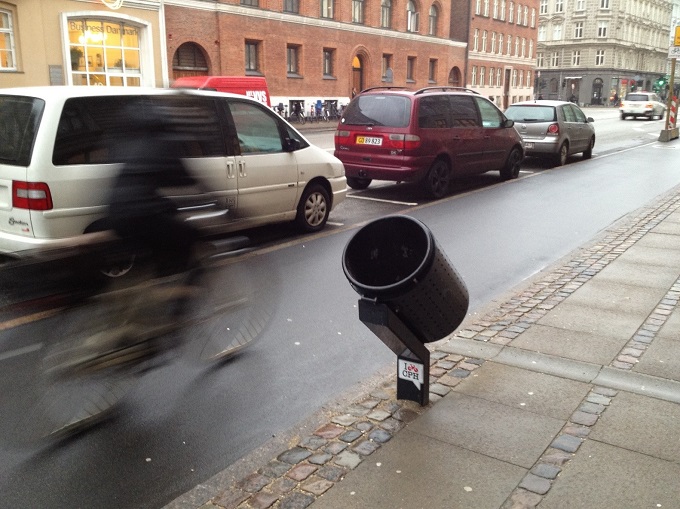
- Den skråtstillede skraldespand til cyklisterne er en af de mange små ting på ruten, der virker som et skulderklap. Foto: Troels Andersen
Tilted rubbish bins for cyclists are one of the details along the route that are a pat on the shoulder. Photo Troels Andersen
See video of cycle superhighways in Odense:
- Cycle superhighway on Odins bridge seen from above
- Cycle superhighway Centrum route
- Cycle superhighway Langesøstien
Sources


